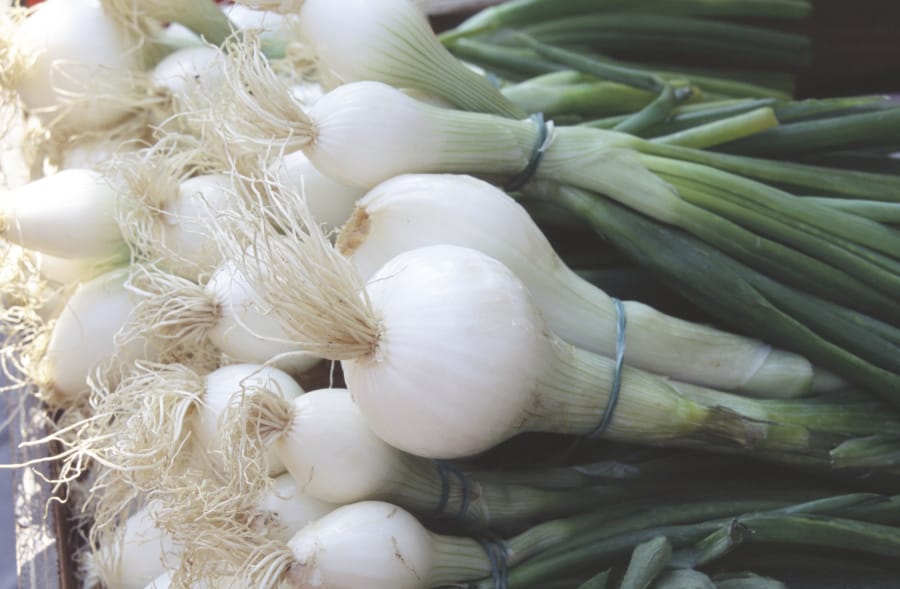If you are someone who likes to cook with onions, there are two other vegetables that deserve your attention. Leeks and shallots are cousins in the Allium family, which also include onions, chives and garlic. If you have never tried them in your favorite recipes, you are in for a delightful surprise!
Leeks might resemble green onions on steroids, but their mild flavor brings subtlety to any dish that onions just can’t quite deliver. The white/pale green base of the leek is the edible part, although the tougher greens can be used to add flavor to stocks and soups. For this purpose, tie a bundle with cotton string, toss it into the pot and remove before serving.
Choose leeks with as much white and light green as possible; smaller leeks have a milder flavor. The stalks should be fresh and firm; avoid those that have withered or begun to turn brown. Store unwashed leeks in a plastic bag for up to two weeks in the fridge.
Before using, leeks need to be thoroughly cleaned. This is easily done by slicing the leek lengthwise and rinsing well under cold water. Remove the dark green stalks and the roots and slice the white portion into desired size. Rinse slices in a colander under cold running water.
Equivalents
Leeks
2 pounds leeks = 1 pound cleaned and trimmed
1 pound leeks = 2 cups chopped, raw
1 pound leeks = 1 cup chopped, cooked
1 pound leeks = 2 large or 3 medium leeks
Shallots
1 pound shallots = 12-15 medium bulbs
1 medium shallot = ½-oz or 1 tablespoon minced
3 medium shallots = 1 small onion
Raw leeks add savory crunch to salads and sandwiches, while lightly sauteing them brings out their natural sweetness. Try them in soups, casseroles, omelets and quiche for a lovely mellow flavor.
One leek contains about 40 calories, and is a source of vitamin K, manganese, B6, copper, iron, folate and vitamins A and C.
While leeks might look like overgrown green onions, the shallot resembles a slimmed-down brown onion, and its flavor is sweeter and milder than the onion with just a hint of garlic. When peeled, shallots separate into cloves, similar to garlic. Both leeks and shallots are in season from May-September in the Pacific Northwest.
Look for dry, firm bulbs with no sprouting and with papery skin. Store unwashed shallots in a cool dry place for up to a month. Smaller shallots will have a sweeter flavor.
Shallots are rich in fiber, potassium, folate, manganese and vitamins A, C and B6. One tablespoon of chopped shallot has 7 calories, with 30 calories in one whole bulb.
Shallots can be used raw or in cooked dishes as a milder substitute for onions. A favorite of my family is caramelized shallots served as a side dish. Simply peel and trim one pound of similar-sized shallots and brown in 3 tablespoons each of butter and sugar. Cook on medium heat until lightly brown, then pour into a baking dish or ramekin and bake at 400 degrees for 15-20 minutes, or until shallots are tender. Top with a dash of balsamic vinegar and serve.
Leeks and shallots can be chopped and frozen. Dice them into uniform pieces and spread on a baking sheet for quick freezing. When solid, transfer to a freezer-safe container or bag and store for up to six months. Since they will be frozen individually, you can pull out just what is needed for a cooked recipe.
Another way to preserve leeks and shallots for adding to cooked recipes, soups and sauces is to dehydrate them for long-term storage. Dice into 1/4 -inch pieces and spread evenly on dehydrator trays. Set the dehydrator temperature to 130 degrees. Leeks should take 6-8 hours and will be dry and brittle when done. Shallots require 8-10 hours and should be dry and slightly leathery. Store in airtight containers.
For additional leek and shallot recipes and serving suggestions, check out Chef Scotty’s Market Fresh Recipes at http://ext100.wsu.edu/clark/?p=8163.
The FINI program provides help to SNAP consumers to purchase more fruits and vegetables at local farmers markets. Find out more at https://www.clark.wa.gov/public-health/snap-farmers-markets.
Judi Seifert is a Clark County WSU Extension Master Food Preserver. For additional recipes, food preservation and food safety information, visit http://ext100.wsu.edu/clark/?p=1134. Call the master food preservers’ help line at 360-397-6060, ext. 5366, or join the Facebook discussion group “WSU Home Food Preservers – Clark County.”



